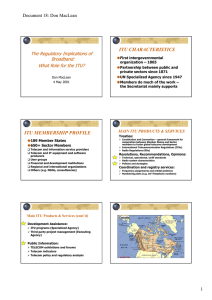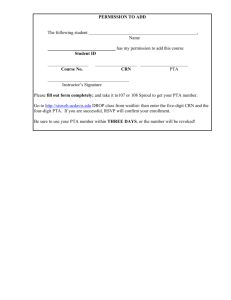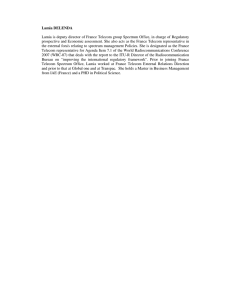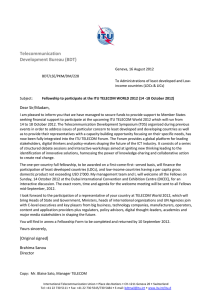“ How user’s expectations have changed and
advertisement
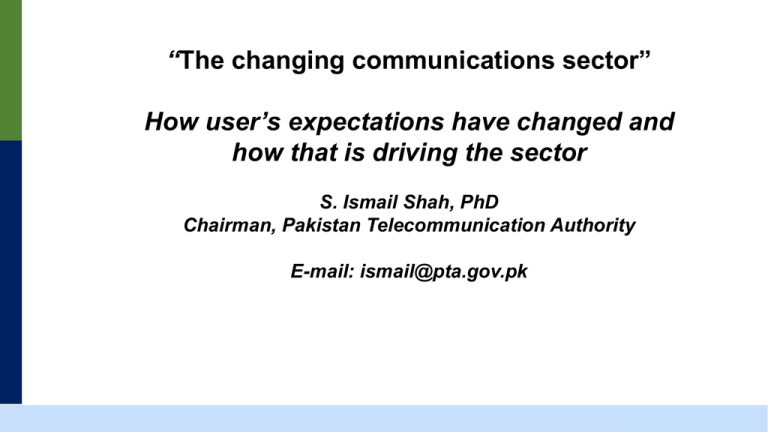
“The changing communications sector” How user’s expectations have changed and how that is driving the sector S. Ismail Shah, PhD Chairman, Pakistan Telecommunication Authority E-mail: ismail@pta.gov.pk | Pakistan Telecommunication Authority Formed in 1996 ( in the first 53) Divisions: Licensing, Strategy and Development, Services (Type Approval, Consumer Protection), Finance, Revenue Assurance, Audit, Enforcement, IP and Web Analysis, Commercial and Economic Affairs. No direct budget from the government Five Cellular, 100s of CVAS, 14 LDI, 8 LL operators UMTS (GSM, GPRS, EDGE, Rel. 99, HSPA+ DC), LTE Rel. 9, CDMA2000 EVDO Rev. B, Wimax, FTTH, xDSL Tele-density 78%, Area coverage 90%, Population coverage 95% ITU CoE on Policy and Regulations Professional Development and Diversity | Once Upon a time SOURCE: M. A. Hayat, LIRNE Asia, PIRRC, WB | Convergence at All Levels SOURCE: M. A. Hayat, LIRNE Asia, PIRRC, WB | Evolving & Vibrant Telecom Sector : 2G,3G,4G available for Consumers Key Facts Rapidly evolving Telcom Sector Perception shift from Voice towards Data driven usage Approximately 6.8 billion wireless service subscriptions worldwide as of 2013, up from 5.9 billion in 2011(ITU) Continuing evolution of advanced wireless technologies, including more smartphones & wider availability of 3G and 4G services Telecommunications industry share is about a $5.0 trillion sector in 2013, up from $4.7 trillion for 2012 (ITU) SOURCE: ITU, GSMA | Changing Telecom Sector: Forecast of Consumer shift from voice to data via 3G/4G Conclusion A shift in user pattern is seen and projected with changing Telecom Technology Forecast project more users adopting 3G/4G as appetite for high speeds for data usage has emerged Customers are consuming fewer voice minutes and data usage is rising exponentially SOURCE: http://eecatalog.com | Changing Dynamics of Telecom and IT Sector Expected Impact Modernization of existing mobile networks Growth of device market Innovative Apps development Digitization impact on Social & Economical sectors e.g. E/M governance, E-Education SOURCE: NSN | Projection: Changing communication trends towards mobile internet use Findings It is predicted that the number of mobile internet subscriptions via smartphone, tablet or any other device with a cellular connection up to to 6.4 billion by 2019 Asia-Pacific region leads in mobile traffic consumption with average user consumption of 1.1 gigabytes per month Lowest data consumption is within Africa where the average mobile phone user consumes just 21MB of data per month due to low smartphone penetration SOURCE: Ericsson | Internet Usage through mobile devices : How its redefining communication trends A survey, conducted across 13 countries in Europe, Latin America and South Africa by Accenture highlights key trends in the digital consumer’s behavior that have implications in telecommunications, media and technology sectors 69% 61% 62% 46% 71% 57% of all Internet users access web via a mobile device of those users accessed through a smartphone, 37% through a netbook and 22% through a tablet of users accessed online communities such as Facebook survey users conducted a banking transaction using their mobile device downloaded programs or apps on their mobile device downloaded or viewed short videos (less than 5 minutes) Core Findings Growing use of mobile Internet Opportunity for providers to offer innovative new services Availability of mobile broadband has triggered higher usage of smart phones and devices, a growing industry for device manufacturers App market is on the rise and high demand exists from user to have app that can facilitate their lives Internet through mobile devices poised to outpace access from stationary devices SOURCE: http://www.accenture.com | Driving factors behind Industry change & Customer expectations : The OTT market Conclusion More data is being consumed globally per year, bar chart on left reflects the type of services filling the capacity up Introduction of innovative services and apps such as Facebook, Youtube etc. have played instrumental role towards changing user expectations Real-time and reliable connectivity has become the expected standard for customers Service providers have changed their old customer service methodologies to align with these new patterns of customer behavior SOURCE: http://www.accenture.com | Customer Expectations and how it is driving the sector Price • With the technology advancement, customers demand on the operator is to offer advance technology with higher speeds • Operators are upgrading networks with 3G/LTE to cater for this customer demand Higher user speeds needed SOURCE: PTA Data • Price is a driving factor for “switchers” and keeping operators on toes to offer competitive rates • Quality of the network is an important criterion in choosing a network provider for access to the Internet over a mobile device • Strong Coverage footprint is also a main driver for customer while choosing a service provider Network Reliability (QOS & Coverage Rollout) | Conclusion: Consumer expectations from Telecom Sector Reliability from the customer’s perspective is defined as “having access to the network anytime, anywhere” it is the service provider who is responsible for delivering this experience. Poor coverage, dropped calls or interrupted transactions can be a cause of lost business and consumer dissatisfaction. Service providers work hard to expand coverage footprint and offer high level of QOS to address this concern Slow speeds must be minimized, users want to carry out tasks with little effort or difficulty. Devices and apps play an important part here, but so do the network and its speed. Service providers are adopting to newer technologies like 3G/4G and buying more spectrum to achieve higher data speeds Application usage and development: Making life easy Pricing is always a big concern for customers and a major factor towards provider loyalty. Service provider constantly review offered plans and try to offer the most competitive rates to prolong consumer loyalty SOURCE: PTA | Telecom Sector adapting to consumer trends and requirement The next phase of development revolves around the digital economy. Trans-sector services such as e-health, tele-education, e-government, incorporating M2M. Embracing the OTT model opens the way for telcos to start offering certain services internationally. An OTT business model allows the world to become their marketplace. Amount of spectrum needed to satisfy consumer demand from mobile phones, tablets & smart devices is going to be limitless. Mobile carriers are scrambling for spectrum. Regulators need to foresee this rising demand and plan accordingly SOURCE: PTA | Challenges Faced by regulator Competition, keeping a balance between different types of licenses (Fixed, limited mobility, fully mobile) OTT eating up the voice minutes Content Regulations Licensing regimes (Mobile TV ): Converged Regulators and non-converged regulators Availability of Spectrum (off loading, white spaces, spectrum sharing) Convergence: How to handle? Net Neutrality and Internet of things Consumer Protection Data Sharing and analysis Broadband Plans SOURCE: PTA | Thank You E-mail: ismail@pta.gov.pk |

